Muskox (Ovibos moschatus)

Muskox (Ovibos moschatus)
×


Muskox (Ovibos moschatus)
About Muskox (Ovibos moschatus)
- Kingdom: Animals
- Phylum: Chordates
- Class: Mammals
- Order: Even-toed Ungalates and Cetacean
- Family: Bovids
The muskox is a hoofed mammal of the family Bovidae. Native to the Arctic, it is noted for its thick coat and for the strong odor emitted by males during the seasonal rut, from which its name derives. This musky odor has the effect of attracting females during mating season. Its Inuktitut name "umingmak" translates to "the bearded one".
Source: Wikipedia
Lifelists
Trips
Visits
-
2000-06-15
Arctic National Wildlife Refuge, United States of AmericaFirst seen traversing a small hill, and then the next day, we saw the group hanging out in the river. -
-
2014-07-17
Nome--Safety Sound, United States of America





